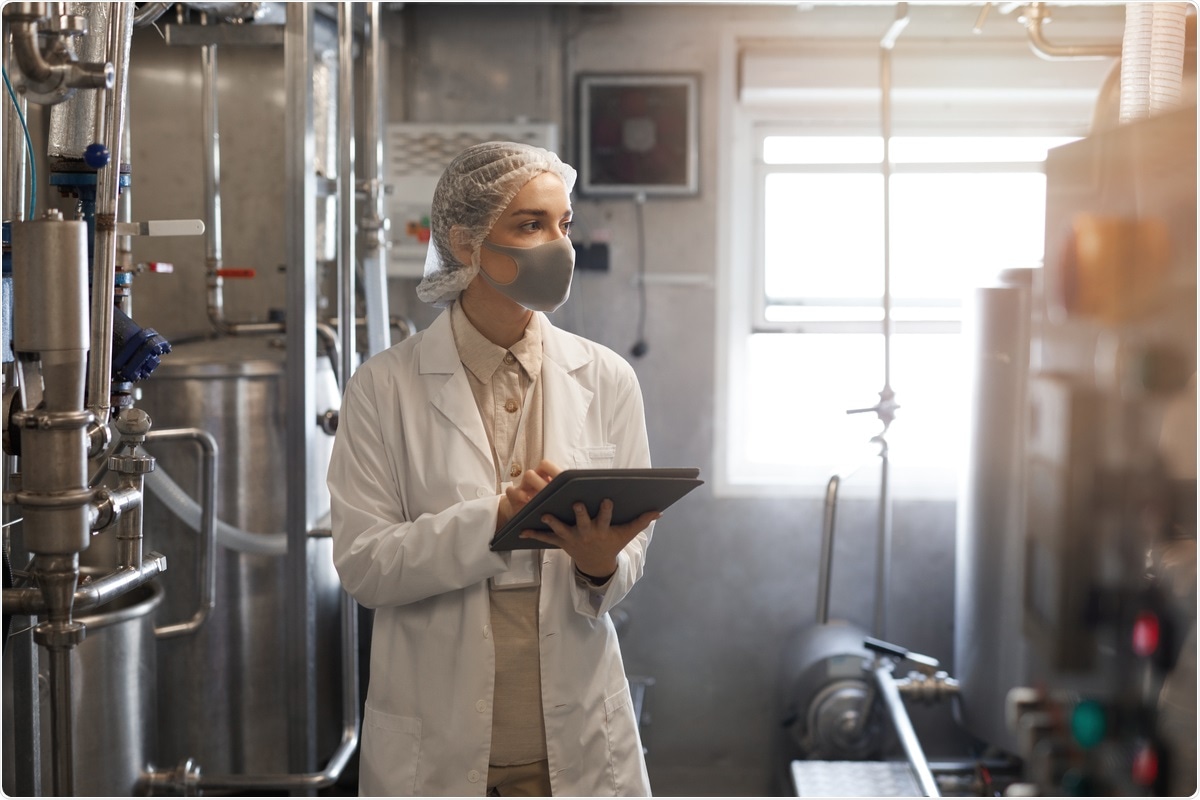A team of researchers from the United States Department of Agriculture examined how the coronavirus disease 2019 (COVID-19) pandemic has changed food practices and safety protocols for workers in food-processing plants.
The world is currently experiencing several supply chain issues as a direct result of extensive lockdowns and impacts on essential workers' safety. However, disruption in the food supply, while catastrophic in nature, has created opportunities for the advancement of medical science, data processing, security monitoring, foodborne pathogen detection, and food safety technology,” wrote the research team.
The review “Food safety lessons learned from the COVID‐19 pandemic” was published in December in the Journal of Food Safety.

SARS-CoV-2 concerns in food-processing plants
SARS-CoV-2 can transmit in the air through infected individuals coughing, sneezing, or talking via large aerosol droplets. Because aerosol droplets can linger in the air for some time indoors, infection containment strategies are needed to avoid the risk of exposure and contamination in food-processing factories. The evaporation and inactivation of these aerosols and other droplets are not well understood and may be needed to modify conditions that decrease the risk of spread.
The risk of SARS-CoV-2 is dependent on the environmental conditions surrounding the type of food being produced. For instance, while fruits and vegetables are refrigerated during processing, this might not be the same storage plan in households.
Current research suggests that lower air temperatures enhanced coronavirus virus survival, possibly slowing reaction rates.”
The researchers say it’s important for food storage and food contact surfaces to survive in different temperatures and humidity. Some research has suggested that food storages that promote moisture removal in the air can inactivate the coronavirus.
Not all disinfectants are created equal
Hand sanitizers are a hot commodity with people during the pandemic. The EPA List N recommends creating antimicrobial products effective in inactivating a non-enveloped virus. Most sanitizer companies currently adhere to these guidelines, but chlorine-based products aren’t as effective as a disinfectant. The researchers say food-processing places should be aware of disinfectants that have been shown to reduce the risk of lingering SARS-CoV-2.
This is even more important as there is a small risk of SARS-CoV-2 staying on objects such as propylene plastic surfaces and stainless steel for up to 72 hours.
Although significant efforts have been focusing on the effectiveness of various disinfectants on HCoV, including SARS-CoV-1and SARS-CoV-2, similar information conducted associated with the food processing environment is significantly lacking and needed.”
Reducing coronavirus exposure between workers
Food-processing plants initially followed the guidance provided by the U.S. Department of Labor. Still, it was based on traditional infection prevention instead of considering the unique situation created by SARS-CoV-2. Many measures focused on creating more engineering and administrative practices, which is impractical for processing food.
As a result, many food-processing plants relied on personal protective equipment (PPE) to minimize contact and potential exposure to the virus. Given the essential role in feeding society, the researchers reason that these workers should be wearing masks, although information is still limited if surgical masks are sufficient for the food sector.
However, with the knowledge on the persistence of SARS-CoV-2 on surfaces, it is very likely that both symptomatic and asymptomatic food handlers can transfer respiratory droplets on food items and food contact materials, by touching eyes and mucosal membranes. Therefore, wearing of appropriate PPE and social distancing is vitally important for essential workers handling food. It is important to consider identified hazards for any employee safety program to successfully perform tasks safely with low to negligible risks of infection,” wrote the researchers.
Using data to assess risk
Data science can analyze historical data to find places with the highest risk for COVID-19 infection. Doing so can prioritize areas that need more PPE and other resources.
Providing datasets to workers and customers helps keep everyone informed of current practices and relieves apprehension over contaminated products. They suggest that with more people buying their groceries online, online tools can be developed for enhanced monitoring. One idea is smart labels on food. This could watch for ambient conditions and provide information regarding potential temperature abuse and impacts on the food’s shelf-life.
In summary, the COVID-19 pandemic has posed unprecedented challenges to the security and safety of the food sector, but with the help of scientists and technologists, we can overcome these challenges and succeed in providing safe, nutritious, and sufficient food to the global population.”
- Lacombe A, et al. Food safety lessons learned from the COVID‐19 pandemic. Journal of Food Safety, 2020. doi: https://doi.org/10.1111/jfs.12878, https://onlinelibrary.wiley.com/doi/10.1111/jfs.12878
Posted in: Medical Science News | Medical Research News | Disease/Infection News | Healthcare News
Tags: Agriculture, Contamination, Coronavirus, Coronavirus Disease COVID-19, Coughing, Disinfectant, Food Safety, Labor, Pandemic, Pathogen, Personal Protective Equipment, PPE, Research, Respiratory, SARS, SARS-CoV-2, Sneezing, Vegetables, Virus

Written by
Jocelyn Solis-Moreira
Jocelyn Solis-Moreira graduated with a Bachelor's in Integrative Neuroscience, where she then pursued graduate research looking at the long-term effects of adolescent binge drinking on the brain's neurochemistry in adulthood.
Source: Read Full Article